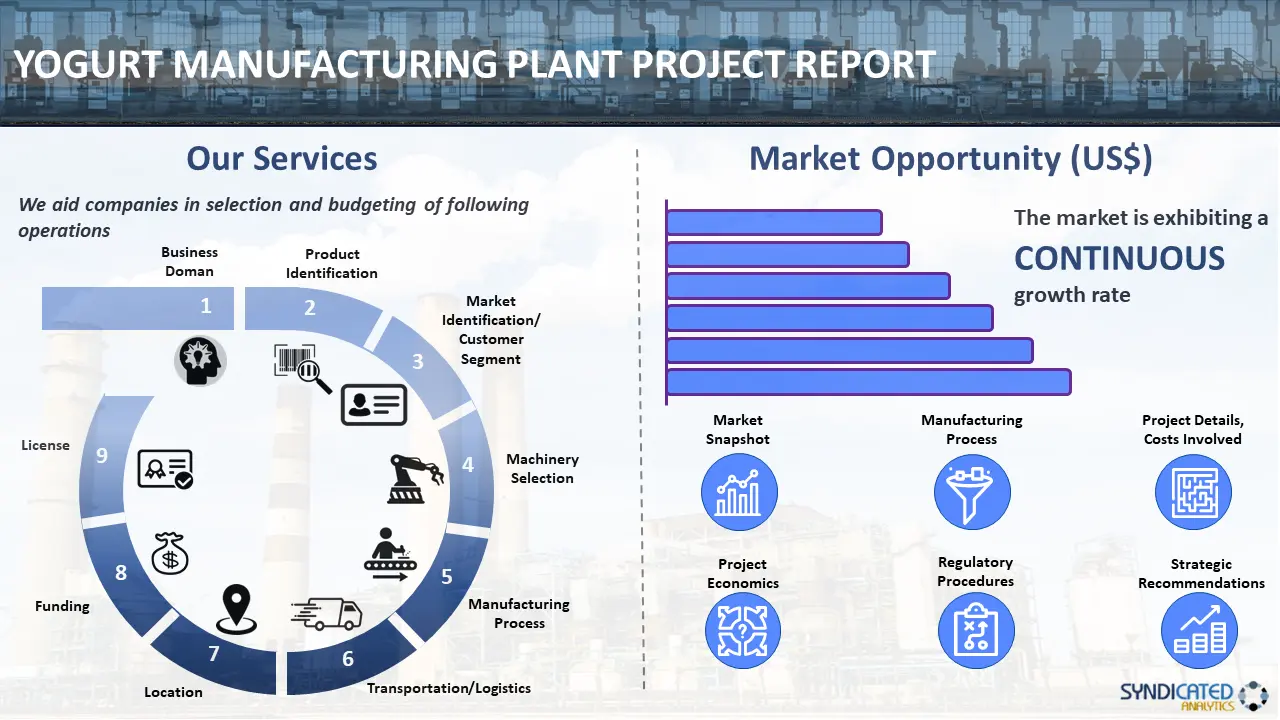
Yogurt Manufacturing Plant Project Report 2025 Edition
Report Coverage: Industry Analysis (Market Performance, Segments, Price Analysis, Outlook), Detailed Process Flow (Product Overview, Unit Operations, Raw Materials, Quality Assurance), Requirements and Cost (Machinery, Raw Materials, Packaging, Transportation, Utility, Human Resource), Project Economics (Capital Investments, Operating Costs, Profit Projections, Financial Analysis, Revenue), and Investment Opportunities
Report Review:
Syndicated Analytics report, titled “Yogurt Manufacturing Plant Project Report 2025 Edition: Industry Analysis (Market Performance, Segments, Price Analysis, Outlook), Detailed Process Flow (Product Overview, Unit Operations, Raw Materials, Quality Assurance), Requirements and Cost ( Machinery, Raw Materials, Packaging, Transportation, Utility, Human Resource), Project Economics (Capital Investments, Operating Costs, Profit Projections, Financial Analysis, Revenue), and Investment Opportunities” provides a complete roadmap for setting up a yogurt manufacturing plant. It covers a comprehensive market overview to micro-level information such as unit operations involved, raw material requirements, utility requirements, infrastructure requirements, machinery and technology requirements, manpower requirements, packaging requirements, transportation requirements, etc. The report provides detailed insights into project economics, including capital investments, project funding, operating expenses, income and expenditure projections, fixed costs vs. variable costs, direct and indirect costs, expected ROI and net present value (NPV), profit and loss account, financial analysis, etc. This report is a must-read for entrepreneurs, investors, researchers, consultants, and business strategists with a stake in the yogurt industry. It provides an in-depth analysis of the industry's current state and future potential, offering valuable insights for decision-making and strategy development. The report is an indispensable resource that offers a detailed examination of the yogurt industry. It is a valuable tool for anyone seeking to establish a foothold in this dynamic sector.

Yogurt is a slightly sour, semi-solid liquid made from milk that is fermented by added bacteria. It is prepared using a culture of Lactobacillus delbrueckii subsp. bulgaricus and Streptococcus thermophilus bacteria. The fermentation of sugars in the milk produces lactic acid, which then acts on milk protein to provide yogurt its characteristic texture and tart flavor. It is a rich source of vitamin B12 and riboflavin. It also contains minerals, such as magnesium, phosphorus, and potassium. As a result, its consumption offers several health benefits, such as reducing the risks of heart diseases and osteoporosis, aiding in weight management, promoting healthy digestion, protecting against colorectal cancer, improving the immune system, and reducing high blood pressure and bad cholesterol.
Market Trends/Drivers:
The global market is majorly driven by the rising awareness regarding the health benefits associated with the consumption of yogurt. In line with this, the rapid expansion of the online and offline organized retail sector and the inflating per capita income levels are significantly contributing to the market across the globe. Apart from this, the availability of numerous flavors of yogurt is creating a positive outlook for the market. Moreover, with the growing trend of veganism, the demand for non-dairy-based yogurt products is continually increasing, which, in turn, is driving the market across the globe. Besides this, the escalating demand for probiotic food and beverages among the masses is further catalyzing the product uptake. Additionally, several manufacturers are also launching fortified product variants with added vitamins, minerals, and fiber, thus propelling the market growth.
The report provides a techno-commercial roadmap for setting up a yogurt manufacturing plant. The study covers all the requisite aspects that one needs to know while making a foray into the yogurt industry. This ranges from macro overview of the market to micro details of the industry performance, key success and risk factors, manufacturing requirements, project cost, project economics, expected returns on investment, profit margins, etc. This report is a must-read for entrepreneurs, investors, researchers, consultants, business strategists, and all those who have any kind of stake in the yogurt industry.
The project report covers the following aspects of the yogurt market:
- Market Snapshot:
- Market Performance
- Market Breakup by Segment
- Market Breakup by Region
- Price Trends
- Impact of COVID-19
- Market Outlook
- Manufacturing Process:
- Product Overview
- Detailed Process Flow
- Unit Operations Involved
- Mass Balance and Raw Material Requirements
- Project Details, Requirements and Costs Involved:
- Land, Location and Site Development
- Plant Layout
- Machinery Requirements and Expenditures
- Raw Material Requirements and Expenditures
- Packaging Requirements and Expenditures
- Transportation Requirements and Expenditures
- Utility Requirements and Expenditures
- Manpower Requirements and Expenditures
- Project Economics
- Capital Investments
- Operating Costs
- Expenditure Projections
- Revenue Projections
- Profit Projections
- Financial Analysis
- Regulatory Procedures and Approval
- Key Success and Risk Factors
Key Questions Answered in This Report?
- What are the key success and risk factors in the yogurt industry?
- How has the yogurt market performed so far and how will it perform in the coming years?
- What is the structure of the yogurt industry and who are the key players?
- What are the various unit operations involved in a yogurt manufacturing plant?
- What is the total size of land required for setting up a yogurt manufacturing plant?
- What are the machinery requirements for setting up a yogurt manufacturing plant?
- What are the raw material requirements for setting up a yogurt manufacturing plant?
- What are the utility requirements for setting up a yogurt manufacturing plant?
- What are the manpower requirements for setting up a yogurt manufacturing plant?
- What are the infrastructure costs for setting up a yogurt manufacturing plant?
- What are the capital costs for setting up a yogurt manufacturing plant?
- What are the operating costs for setting up a yogurt manufacturing plant?
- What should be the pricing mechanism of yogurt?
- What will be the income and expenditures for a yogurt manufacturing plant?
- What is the time required to break-even?
Need a Customized Project Report?
Although we have tried to make the report as comprehensive as possible, we believe that every stakeholder may have their specific requirements. In view of this, we can customize the report based on your particular needs. You can share your business requirements with our consultants, and we will provide you a tailored scope. Some of the common customizations that our clients request us include:
- The report can be customized based on the country/region that you plan to set up your plant.
- The manufacturing capacity of the plant can be customized based on your requirements.
- Machinery suppliers and costs can be customized based on your requirements.
- Any additions to the current scope can also be provided based on your requirements.
Why buy Syndicated Analytics reports?
- Our reports provide stakeholders insights into the viability of a business venture, allowing them to take informed business decisions.
- We have a strong network of consultants and domain experts in 100+ countries across North America, Europe, Asia Pacific, South America, Africa, and the Middle East.
- We have a strong database of equipment and raw material suppliers across all major continents.
- We regularly track and update land costs, construction costs, Utility costs, labour costs, etc across 100+ countries around the globe
- We are the trusted business partners to the world’s leading corporates, governments, and institutions. Our client list ranges from small and start-up businesses to fortune 500 companies
- Our strong in-house team of engineers, statisticians, modelling experts, charted accountants, architects, etc. have been instrumental in building, expanding, and optimizing sustainable manufacturing plants across the globe.
Purchase Options
Ask For Customization
Personalize this research
Triangulate with your own data
Get data as per your format and definition
Gain a deeper dive on a specific application, geography, customer or competitor
Any level of personalization
Get in Touch
Call us on
US: +1-213-316-7435
Uk: +44-20-8040-3201
Drop us an email at
sales@syndicatedanalytics.com